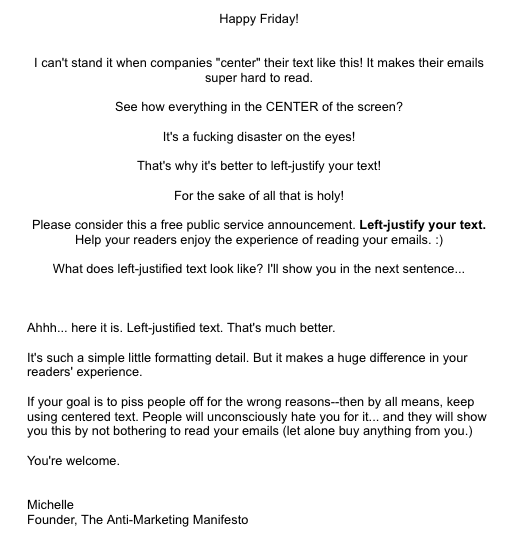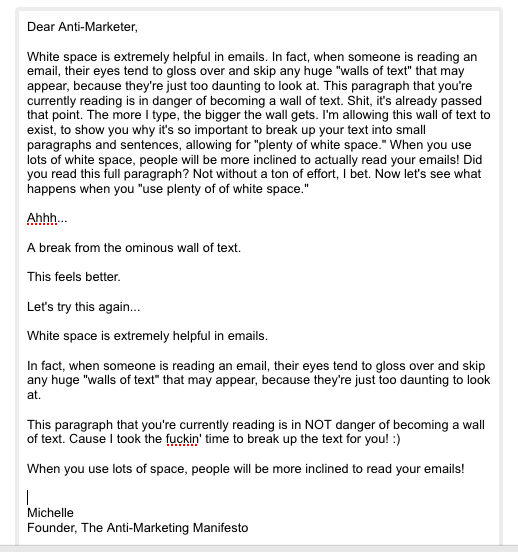Complexity is the enemy. That’s why I have one rule above all else, when it comes to writing emails to your list:
Keep your emails simple.
Keep everything super clean, easy to read, and easy to understand.
Each email you write should be as simple as possible, and no simpler. If it feels “hard,” you might be over-thinking it. Stick to the basics.
If you follow just that rule alone, you will succeed.
But if you need more…
I’ve compiled my top 10 tips for writing successful emails. These are based on my 14+ years of writing email articles, newsletters, and promos for my clients’ email lists (as well as my own list).
Following these tips will help you motivate, educate, inspire (MEI) more people…which will lead to more sales.
First I’ll give you a quick overview, then we can dive deeper into each tip.
10 Tips for Writing Successful Emails (Overview)
1. Focus on ONE big idea per email.
2. Left-justify all text and DO NOT CENTER IT!
3. Use plenty of white space.
4. Use clear, simple language in your writing.
5. Use plain black text 80% of the time.
6. Keep it personal.
7. Add insight to every email.
8. Occasionally add an interesting pic to your email.
9. Include a Call to Action (CTA) in each email (optional).
10. Use unique subject lines that pique curiosity.
Now let’s dig into each one more closely…
10 Tips for Writing Successful Emails (Detailed)
1. Focus on ONE big idea per email. Don’t jam multiple ideas into one email — split them up into separate emails. Otherwise you’ll confuse and overwhelm people.
For example, if you’re educating people about your Product A, then make sure to focus solely on Product A in your email. Don’t tell them about Product B, Product C, and Product D in the same email… Break those up into individual emails, each with “one big idea.”
2. Left-justify all text and DO NOT CENTER IT! Centered text is awkward and hard to read. I don’t know why the hell people still use it. Make the appearance of your text easy on the eyes. Example:

3. Use plenty of white space. Use short sentences whenever possible. Vary the size of your paragraphs. Don’t write huge “walls of text” — break them up into smaller paragraphs. Example:

4. Use clear, simple language in your writing. Aim to achieve a 5th grade reading level for each email, which is accessible to all reading levels.
Bonus tip: I use the Readable app (www.readable.com) to measure the readability of my writing, as well as my clients’ writing. Higher numbers equate to convoluted, difficult writing (think: college level text). Lower numbers equate to simpler, clearer writing that’s easy to understand. Simpler writing is better for making sales.
5. Use plain black text 80% of the time. Don’t get tripped up by fancy graphic design or formatting. You don’t need it most of the time. (Do you design all the emails you send to your spouse or friends? No.)
Use occasional branded, designed emails as a way to strengthen your brand, and to remind people of it.
6. Keep it personal. Write your emails using the same tone, style, personality, and level of candor and honesty that you’d use when writing to a close friend.
7. Add insight to every email. Each email should contain a helpful idea, concept, nugget of truth, or actionable insight that improves readers’ lives or makes them think differently about something.
Don’t make people click on a link in order to read your full article (unless the article is super long).
Avoid spammy content such as “Save 20% off blah blah…” that doesn’t include any insight. Always wrap your offer around something EDUCATIONAL that also motivates and inspires!
8. Occasionally add an interesting pic to your email. So that people can see you’re a real human being, you can add a pic at the top of your email (before the body of the text) to personalize it. You don’t have to include a pic in every email.
9. Include a Call to Action (CTA) in each email (optional), in the manner that works best for you. Some businesses do well with a bold, direct, “in-your-face” CTA. Others do better by using more subtle CTAs that are more like “irresistible invitations” rather than calling someone to take an action.
Experiment with different approaches and find what works best for you.
10. Use unique subject lines that pique curiosity, while offering a tangible benefit.
For example, this subject line would pique my readers’ interest:
Subj: “F#ck this marketing formula…do this instead!”
Avoid using vague, gimmicky, or cliché subject lines that don’t provide any insight (e.g., Subj: “so…now what???!!!” or “AMM Newsletter Issue #314.”)
Avoid putting your name in the subject line, since it’s already in the “from” field.
A Tip to Help You Begin Writing
If I’m finding it hard to write a particular email or blog article, I’ll put a focusing question at the top of my blank document. This helps to clear my mind.
Any time you ask your brain a question, it will immediately begin searching for an answer. What you search for, you will find.
Here are some example questions you can write at the top of your document (or page) to help you get focused:
HOW CAN I WRITE THIS EMAIL IN A WAY THAT WILL HELP READERS IMPROVE THEIR LIVES?
WHAT NEEDS TO BE STATED IN THIS EMAIL?
HOW CAN I FINISH THIS ARTICLE IN 30 MINUTES OR LESS?
WHAT CAN I WRITE THAT WOULD BE OF MOST BENEFIT TO ALL PARTIES INVOLVED?
DEAR GOD/SOURCE/UNIVERSE: WHAT DO YOU WANT ME TO SAY IN THIS EMAIL?
Bonus: These kinds of open-ended questions double as a “prayer” to help you achieve a positive outcome!
Happy emailing!
Michelle
P.S. Want my help writing or editing your email articles or newsletter? Reach out to me here.

 Michelle Lopez Boggs is a copywriter, copywriting mentor, and author of "The Anti-Marketing Manifesto: How to Sell Without Being a Sellout." She's helped her clients sell millions of dollars' worth of products and services online by using the MEI(S) principle — motivate, educate, and inspire, and sell.
Michelle Lopez Boggs is a copywriter, copywriting mentor, and author of "The Anti-Marketing Manifesto: How to Sell Without Being a Sellout." She's helped her clients sell millions of dollars' worth of products and services online by using the MEI(S) principle — motivate, educate, and inspire, and sell. 